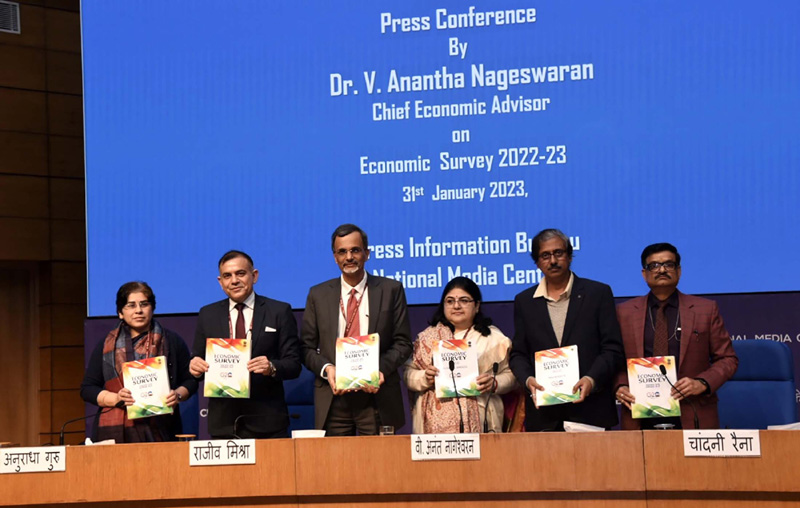 Economic Survey
Economic Survey
Availability and spread of digital infrastructure to contribute significantly to economic growth: Economic Survey
New Delhi: While the role of traditional infrastructure has been well recognised, in recent years, the role of digital infrastructure in socio-economic development of the country has assumed an increased importance, revealed the Economic Survey.
In the coming years, the availability and spread of digital infrastructure will contribute significantly to economic growth, states the Economic Survey 2022 -23 which was presented by the Union Minister for Finance and Corporate Affairs Nirmala Sitharaman in the parliament on Tuesday.
The survey notes that before 2014, access to digital services was perceived as a prerogative of urban households.
However, with the vision of developing digital infrastructure as a core utility for every citizen, Digital India as an umbrella programme was launched in 2015.
It has added more internet subscribers in rural areas in the last 3 years (2019-21) than in their urban counterparts (95.76 million vis-a-vis 92.81 million in rural and urban areas respectively).
This has been a result of dedicated digital drives across rural areas through ambitious government schemes, like the flagship BharatNet Project Scheme, Telecom Development Plan, Aspirational District Scheme, initiatives in North-Eastern Region through Comprehensive Telecom Development Plan (CTDP) and initiatives towards areas affected by Left Wing Extremism (LWE) etc.
The Survey further explains that significant growth in internet subscribers in rural India was the major shock absorber during the COVID-19 pandemic when both businesses and consumer demand were impacted.
Digital infrastructure created over the years ensured not just the continuous transmission of information but also added economic value when businesses went digital.
The 200 per cent increase in rural internet subscriptions between 2015 and 2021 vis-a-vis 158 per cent in urban areas, reflects the increased impetus the government is putting to bring rural and urban digital connectivity to the same level.
For further widening the net, to include unconnected areas and populations, dedicated long-term efforts by the government have been taken observes the Economic Survey.
Government Schemes like Production Linked Incentive (PLI) for telecom and networking products will promote domestic mobile manufacturing as well as network installation. Continuous proliferation of measures such as Bharat Net Project shall continue to improve accessibility, affordability, connectivity, and inclusivity pan-India.
The Economic Survey states that to further create digital linkages at the grassroots level and increase the consumer experience other initiatives include approval of a project for the saturation of 4G mobile services in uncovered villages across the country.
Apart from this, with a special focus on the states in the North-Eastern Region, the government is implementing a Comprehensive Telecom Development Plan (CTDP).
A comprehensive initiative to connect our islands to the mainland has also been realised through the government’s initiative of the Comprehensive Telecom Development Plan for Islands.
The Economic Survey states that a landmark achievement in telecommunications in India was the launch of 5G services.
Telecom reforms and clear policy direction led to the spectrum auction of 2022 garnering the highest-ever bids. As a major reform measure, the Indian Telegraph Right of Way (Amendment) Rules, 2022, will facilitate faster and easier deployment of telegraph infrastructure to enable speedy 5G rollout.
The government has brought in procedural reforms in Wireless Licensing, including delicensing of various frequency bands to promote innovation, manufacturing and export.
The National Frequency Allocation Plan 2022 (NFAP) will give guidance to the users of the spectrum to plan their networks in accordance with the relevant frequency and parameters provided therein.
The Economic Survey observes that journey of Digital Public Infrastructure has been remarkably memorable, dating to 2009, when Aadhaar was first launched. It is fourteen years now, and the digital journey since then has taken the country quite far.
The three growth drivers that acted as catalysts for DPI growth were favourable demographics, vast expansion of the middle-class, and digital behaviour patterns. By leveraging these growth drivers, India has built a competitive digital economy that empowers every individual and business to transact paperless and cashless.
Various schemes and applications launched by the government such as ‘MyScheme’ and Unified Mobile Application for New-Age Governance (UMANG), ‘Bhashini’ and others enable citizens to access e-Government services offered by the Central and State Government in various sectors.
Through platforms like OpenForge, the use of open-source software and sharing and reuse of e-governance-related source code is promoted notes the Survey.
Today, we have a powerful story on digital public infrastructure that is finding global resonance the Economic Survey states. The increasing digital adoption during covid-19 in areas like healthcare, agriculture, FinTech, education, and skilling indicates that the digital delivery of services in India has a massive potential across economic sectors. It is usually suggested that developing countries must follow global best practices. However, how India has created and harnessed its DPI is capturing the attention of many nations globally.
The government is committed to keeping pace with the digital landscape developments including those related to legislations and frameworks the the Economic Survey states. While the digital journey started with Aadhaar as a medium for service delivery at the doorstep, UPI strengthened the digital payment infrastructure. With other initiatives like CoWIN, e-RUPI, TReDS, Account Aggregators, ONDC, Open Credit Enablement Network (OCEN) etc. at different stages of implementation, India has developed a unique and cogent digital story to tell. The journey is ongoing and there is much untapped potential in India's digital public infrastructure space. In sum, the synergy between physical and digital infrastructure will be one of the defining features of India's future growth story states the Survey.
Support Our Journalism
We cannot do without you.. your contribution supports unbiased journalism
IBNS is not driven by any ism- not wokeism, not racism, not skewed secularism, not hyper right-wing or left liberal ideals, nor by any hardline religious beliefs or hyper nationalism. We want to serve you good old objective news, as they are. We do not judge or preach. We let people decide for themselves. We only try to present factual and well-sourced news.







